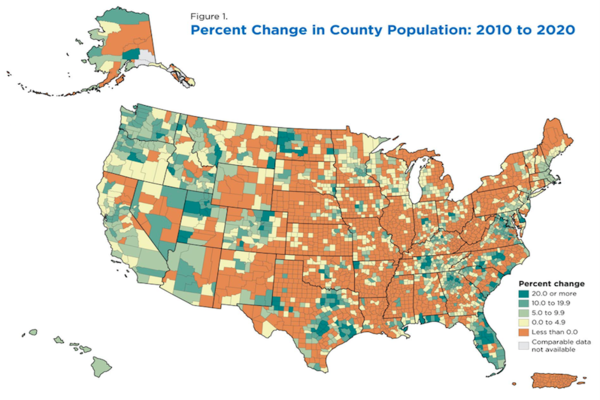I was able to download the county population figures and plug them into a database of previous decades. I like using counties because they're of a useful size and fairly stable in area across the decades, so comparisons are possible.
The first thing I noticed is that 53% of US counties lost population in 2010-20. Considering that only 35% did in 2000-10, that's a hefty number. And they're mostly smaller, rural counties. Even in smaller states, the major urban areas grew while the rest of the state languished. To put a number on it: nationwide, of the 100 largest counties in 2010, 96 gained population in the next decade; of the 100 smallest, only 24 did.
Truly, to those that have, more shall be given.

The orange counties lost population; the rest gained, the darker the blue the greater the gain.
A quick calculation enabled me to determine the fastest-growing counties in the US; this privileges smaller ones, as fewer people are needed to make a big percentage dent. The two fastest-growing counties in the US were North Dakota oil boom counties (this isn't unusual: in the 1920s and 30s almost all of the biggest-growth counties in the US were Texas oil boom counties), and the rest of the top ten mostly on the suburban edges of growing urban areas: San Antonio, Austin, Orlando, yes, but also Des Moines and Sioux Falls. It's around 45-55% growth for these. The county with the greatest absolute growth was Harris County, Texas, but that's already huge (it has Houston).
The county losing the greatest percentage of population was Alexander County, Illinois (36%). Focused on the town of Cairo, it's probably never quite recovered from the 2011 Mississippi River floods. Ten years ago the big loser was a Louisiana rural parish wiped out by Katrina, but now that one's growing back. However, now with Ida they may have to start all over again.

No comments:
Post a Comment